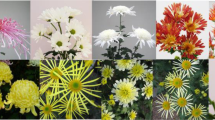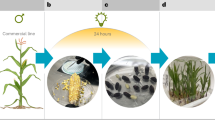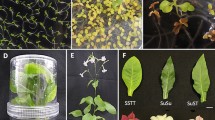Abstract
THE usefulness of colchicine as a chemical in doubling chromosomes in plants was first reported by Blakeslee1, who obtained polyploids in Datura stramonium by treating its seeds with this alkaloid. Since then, colchicine has been extensively used for inducing polyploidy in many species of plants. In announcing an Indian source for colchicine, Parthasarathy2 reported that, if fresh extract of tubers of Gloriosa superba is applied to maize seed before sowing, the developing roots show tetraploid sectors. This confirmed the polyploidizing influence of the alkaloid colchicine present in these tubers, the isolation of which had been reported by Clewer, Green and Tutin3 in 1915.
This is a preview of subscription content, access via your institution
Access options
Subscribe to this journal
Receive 51 print issues and online access
$199.00 per year
only $3.90 per issue
Buy this article
- Purchase on Springer Link
- Instant access to full article PDF
Prices may be subject to local taxes which are calculated during checkout
Similar content being viewed by others
References
Blakeslee, A. F., J. Hered., 28, 393 (1937).
Parthasarathy, N., Curr. Sci., 10, 446 (1941).
Clewer, H. W. B., Green, S. J., and Tutin, F., J. Chem. Soc., 107, 835 (1915).
Subbaratnam, A. V., J. Sci. and Indust. Res., 11, 446 (1952).
Author information
Authors and Affiliations
Rights and permissions
About this article
Cite this article
KUMAR, L. Doubling of Chromosomes induced by Gloriosine isolated from Gloriosa superba, Linn.. Nature 171, 791–792 (1953). https://doi.org/10.1038/171791b0
Issue Date:
DOI: https://doi.org/10.1038/171791b0
This article is cited by
-
Docking experiments suggest that gloriosine has microtubule-targeting properties similar to colchicine
Scientific Reports (2023)
Comments
By submitting a comment you agree to abide by our Terms and Community Guidelines. If you find something abusive or that does not comply with our terms or guidelines please flag it as inappropriate.



